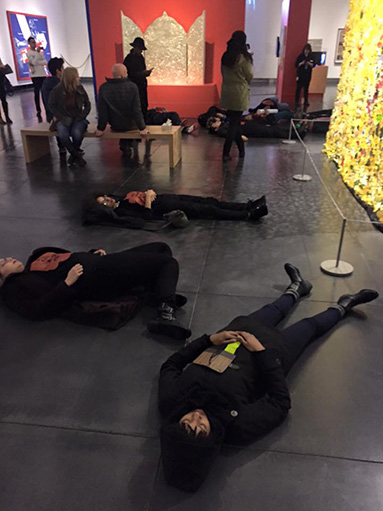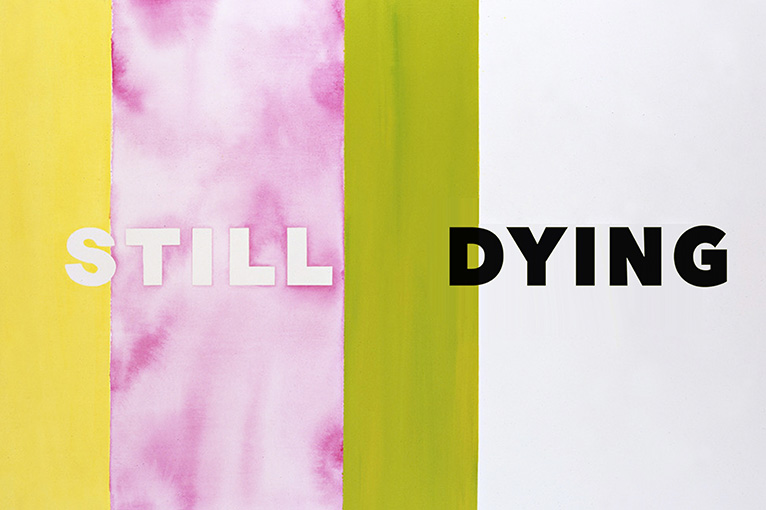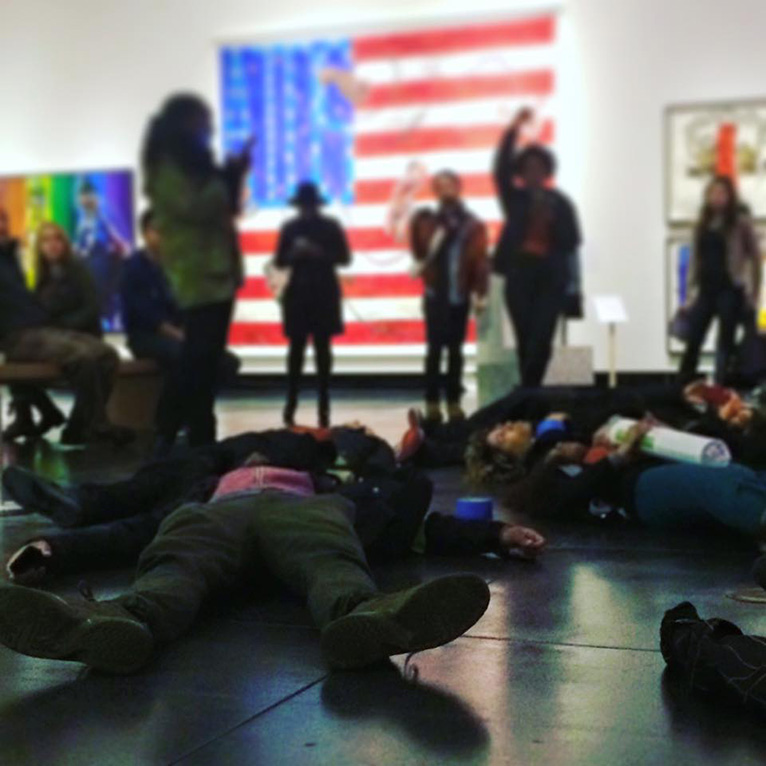A recent protest makes visible the ways that the white gay art establishment maintains the same erasure, censorship and exclusion that fueled the initial AIDS crisis.
On December 17th, 2015, the Tacoma Action Collective staged a die-in at the “Art AIDS America” exhibition, curated by Jonathan David Katz, director of the Visual Studies doctoral program at the University of Buffalo and Rock Hushka, Tacoma Art Museum’s chief curator and currently on view at the Tacoma Art Museum. With chants and decals broadcasting their message "Stop Erasing Black People," they protested both the lack of black representation within the exhibition and the systemic anti-black racism they see within the museum. In anticipation of the demonstration they listed their three demands: “more Black staff at all levels of leadership” at the museum; “Undoing Institutional Racism” retraining for staff and board; and greater black representation within the “Art AIDS America” exhibition for when it tours nationally in 2016.
Theodore Kerr: How did the action come to be?
Tacoma Action Collective: A few of the organizers went to the exhibit, and were appalled. If you read Chris Jordan's interview with Rock Hushka, he gives more details about his reaction. An exhibit about AIDS in America that just about excludes the largest group of people that are affected really shocked and saddened us all. Instead of just talking about how disappointed we were, we immediately took action.
Now, by refusing to act on the concerns of those most heavily impacted, Katz and Hushka are guilty of the same erasure, censorship and exclusion that fueled the initial AIDS crisis. Ironically, older members of the ACT-UP constituency who are also on the roster for the show have reached out and are joining us in protest. These two curators have not only missed the point of this entire body of work, but are now willfully leveraging the spectacle of suffering to spotlight themselves as art historians. They’ve even asked us to do more die-ins within their galleries. It’s time for the public to take a stand and say we are not going to support this false history.
It’s also shameful that the Bronx Museum has supported this project, especially considering that the Bronx is 90% Black and Latino and has the highest infection rate of all NYC. #StopErasingBlackPeople is a call for the entire public to challenge the false histories that are being fed to us. This is a statement to institutions across the country that we won't accept erasure, especially not as our people continue to die. We want the people of NYC, Chicago, and Atlanta to join us in ending this exclusion.

Can you describe how the action was planned, and who makes up the group?
The action actually started with research: Going through all 107 artists to get background information. Although the exhibit looked very white, we wanted to be sure, and not just make assumptions. We found that only five of the 107 artists in the exhibition are black. That is not acceptable. We also compiled a list of about 40 Black HIV+ artists that could have been included in the exhibit.
From there, we simultaneously worked on the logo, t shirts, stickers, brochures, and press release. The day before the die-in, the interview was conducted. It’s important to know that this interview was not an “attack” or “ambush." Rock Hushka met with Black artists in Seattle back in 2011 about this very exhibit. The interview was to get a better idea of why Black people were left out of the exhibit.
Tacoma Action Collective planned the direct action, which included a die-in, a speech about why the action was occurring, chants, and songs. The press release was sent out to the Tacoma Art Museum and media outlets after the action was completed, to ensure we were able to do it. The action is not over. We’re just getting started. There are still several components that are being worked on daily, to continue bringing awareness to all of the issues we highlighted.

Was there talk about reaching out to other communities that are overrepresented in HIV rates, but underrepresented in the exhibition?
Definitely. The organizers of this action are Black, and we love all Black people; ALL OF THEM. So when the question come up about underrepresented people and someone mentions transgender people, we remind them that you can be both Black and trans. We are fighting for ALL Black lives to be represented. When we say stop erasing Black people, we mean ALL Black lives. We want all Black people to be included in this history, because it affects us all.
Our action was meant to bring awareness and attention to an exhibit that excludes marginalized people. It’s our hope that people from other underrepresented communities speak up as well too, but we don’t want to speak for them. As we marched out the doors of TAM we sang “Which side are you on friend, which side are you on? Justice for Black lives is justice for us all."
What have been some of the reactions from people in the community?
We’ve seen a lot of reactions. We’ve seen people support what we’re doing, and start conversations around the issues we’ve brought up. We’ve seen people confused, and shocked that we would “bring race into this." We’ve also seen some people outright call us the n-word in the comment section on the blog where the interview is posted. Overall, it has definitely started conversations in Tacoma, and across the country about HIV/AIDS, art, access to health care, and what it means to erase and exclude Black people from history.
It’s come to light that the writer and activist Kenyon Farrow was asked to consult on the exhibition years ago. He had suggested the curators look into House and Ball culture, the work of Marlon Riggs, and many other ideas, but that did not figure prominently in the exhibition. What was your reaction when you learned about this?
It’s both disheartening and infuriating. To know that the curators had the opportunity to be inclusive, but chose not to, hurts. Prior to the interview [with Hushka], we did know that he had consulted with a group of Black artists in Seattle about this exhibit, but hearing that other Black voices were heard and ignored was very disappointing.
Kenyon also talks about the Basquiat piece which was pulled from the show and how he fought to defend it. It’s shocking to see that even as Basquiat, even as a legend, you’re still expendable in their eyes. This is why we discuss this as exclusion. At every stage in the development of this show, Black perspectives were marginal, disregarded, and moved to the sidelines. When we started our investigation and began to realize what would have been on these walls if Black voices were respected in the curation it became clear that piece by piece our history is being stolen from us. That is something we have to abolish. Now many artists from the roster and consultants on the project have reached out to us and shared their experiences. Some don’t feel ready yet to speak publicly but there’s a frightening pattern here and we have to end it now.
In the interview with Rock Hushka, you speak about other cultural institutions like Visual AIDS and the Bronx Museum. What do you all think is the role of TAM and these other organizations when it comes to issues of representation around the epidemic?
Visibility is actually the beginning. Visual AIDS not only has a valuable role but a responsibility as it relates to dismantling the whitewashed narratives of the crisis as it is currently being historicized. That requires specific partnership and support focusing on archiving Black art history in relation to the historical crisis.
Furthermore looking at the extreme underrepresentation, we think this requires programs that focus specifically on living Black and Latin@ artists, which must include strategies to support Black artists who are positive but who don’t feel safe in publicly disclosing their status. People’s public discretion should not be a token in exchange for being worthy of support. Not only is AIDS not over, but systemic racism, misogyny and classism aren’t over either. So we have to take down as many barriers for support as possible to end the isolation. The ultimate question really is how are Black and Brown people informing the priorities and strategies of Visual AIDS as it stands? How are those most affected steering their mission? That’s where effectiveness begins.
What can art do in a crisis?
Without activism, which leveraged the arts to demand visibility and to demand solutions, the systemic approaches to addressing HIV including medical, policy and social support would not have been sparked.
Behind all of this, creation is how we give ourselves resilience when no one else cares. That has been the history of Black art since the Middle Passage. We can’t allow for our heritage to be co-opted, erased, or bleached out by a couple of middle-aged white guys flailing around for art world chops. We won’t allow for Black people to be told that art history doesn’t include them. Our voices are what we’ve had when we’ve had nothing else.
Who are artists and culture makers you would have liked to have seen in the exhibition?
Art AIDS America says it’s about “the full spectrum of artistic responses to HIV." Obviously we’ve been disregarded and everyone’s been failed by these curators. We don’t want to repeat any of Katz and Hushka’s mistakes by being simplistic or reductive in this.
Writer Timothy DuWhite explains that “Black artists’ work does not have to be about HIV to be about HIV." This is because of how the crisis intersects with everything in our lives as Black people. There is a multitude of Black artists producing “iconic work” whose contributions are not only relevant to the curator's frame but essential to this conversation.
This crisis is represented among Black artists in distinct ways because being the target of state genocide, legislated violence and exclusion was not new for us as Black people. To see the crisis in our work you have to see the multiple crises targeting Black folks at that time which also persist to this day. They are inseparable.
Recognizing these distinctions, we’ve compiled a working list of recognized HIV+ Black artists in all media because we believe that it’s vital to begin with the voices of those most heavily impacted.
Hushka’s suggestion that only the work of white artists have impacted art history is not only dehumanizing but extremely divisive. It pulls us apart. They’ve taken a segregated excerpt of a national movement, put it in a plastic container and literally said this is “the full spectrum of artistic responses to AIDS." What’s far more profound and impactful than sticking to your guns and pretending like you know what you're doing is to say “this issue is so much greater than us, and out of respect for these artists and out of respect for those who have already suffered so much, we are stepping back to change this roster because we want people to understand that HIV impacted everyone and this fight is not over”
What’s the connection between this and national movements against systemic racism and anti-blackness?
Our die-in was about so many things that affect Black people. Mass incarceration, described as “the new Jim Crow,” is fundamental to the HIV crisis that persists among Black and Latino populations. Black people are still not afforded access and equality. This goes for art. This goes for the telling of our history. This goes for healthcare. This goes for education. These are all things we are fighting for with #StopErasingBlackPeople. One of the guiding principles for the Black Lives Matter movement for example is “The most directly affected people are the experts at their own lives and should be in leadership, at the center of our movement, and telling their stories directly." This is something that we have truly embraced with this action. Between Ebola coverage, the movie Stonewall and the white actor cast as MLK, 2015 has been a calendar year for whitewashing, while our people are still dying. We’re fighting to tell our own stories and fighting to represent ourselves because we are the most impacted by this both here and across the globe.
Although it’s extremely sad that the same folks who chained themselves to desks to fight for treatments in the 80’s have to step out and picket again now, it’s also invigorating. Because for Black America, the fight never ended, and now there’s a moment for the public to join us.
Since the die-in the protesters met with staff and Board President of the Tacoma Art Museum. According to TAC, the meeting was productive with the museum stating they are committed to TAM’s three demands going forward. In their official statement TAC states: We are committed to holding the Tacoma Art Museum accountable for their commitments and to engaging with them as a resource.
